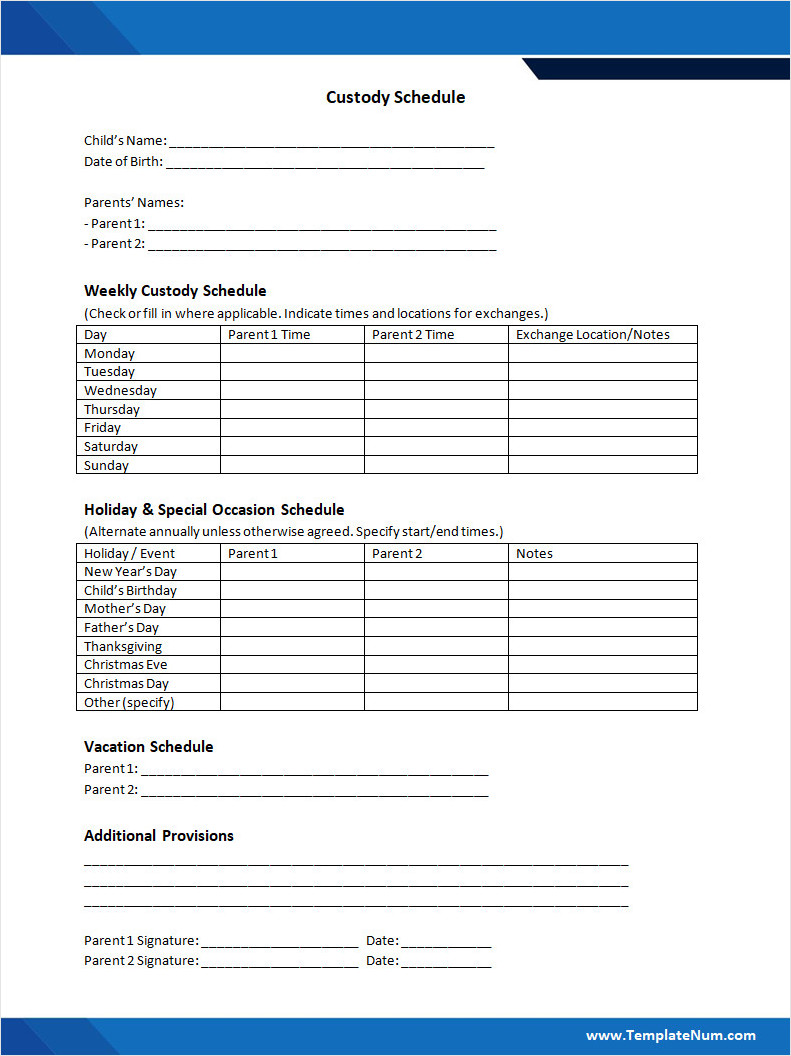Going through a separation or divorce can be a challenging time for families, especially when children are involved. One of the key aspects to consider during this period is establishing a custody schedule that prioritizes the child’s well-being. A custody schedule helps provide stability and routine for the children, minimizing disruptions in their lives and creating a positive and predictable environment.

By outlining specific times each parent spends with the child, setting clear boundaries and expectations, and covering important events like holidays and birthdays, a custody schedule plays a crucial role in ensuring that children’s needs are met during this transitional period.
What is a Custody Schedule?
A custody schedule is a detailed plan that determines when and where a child will spend time with each parent after a separation or divorce. It outlines specific days and times for visitation, as well as arrangements for holidays, vacations, and other important events.
The goal of a custody schedule is to provide a consistent and structured routine for the children, ensuring that they have regular contact with both parents and feel secure in their new family dynamic.
The Purpose of a Custody Schedule
One of the primary purposes of a custody schedule is to minimize disruptions in children’s lives after a separation or divorce. By establishing a clear plan for visitation and parenting time, children can maintain a sense of stability and routine, which is essential for their emotional well-being. A custody schedule also helps parents navigate co-parenting responsibilities by outlining specific guidelines for sharing time with the children.
The Legal Aspects of a Custody Schedule
In many cases, custody schedules are included in formal custody agreements or court orders. These legal documents provide a framework for how parents will share custody of their children, including details about visitation schedules, holidays, and decision-making responsibilities. By formalizing the custody schedule in a legal agreement, parents can ensure that both parties are held accountable for adhering to the terms of the arrangement.
The Benefits of a Custody Schedule
There are numerous benefits to having a custody schedule in place. One of the key advantages is that it helps reduce conflict between parents by providing a clear roadmap for co-parenting responsibilities. By having a predetermined schedule, parents can avoid misunderstandings and disagreements about visitation arrangements, which can ultimately create a more harmonious co-parenting relationship.
How to Create a Custody Schedule
Creating a custody schedule can be a collaborative process between the parents, or it may require the assistance of a mediator or family law professional. Here are some tips for successful co-parenting and creating a custody schedule that prioritizes the child’s well-being:
1. Communicate Openly and Effectively
Effective communication is essential when creating a custody schedule. Both parents should be willing to listen to each other’s concerns and work together to find solutions that meet the needs of the children. Keep the lines of communication open and be respectful of each other’s perspectives.
2. Consider the Child’s Best Interests
When creating a custody schedule, it’s important to prioritize the child’s best interests above all else. Consider factors such as the child’s age, school schedule, extracurricular activities, and personal preferences when determining visitation arrangements. The goal is to create a schedule that supports the child’s emotional well-being and development.
3. Be Flexible and Willing to Compromise
Flexibility is key when co-parenting and creating a custody schedule. Be willing to make adjustments to the schedule when necessary and consider the other parent’s needs and commitments. It’s important to remember that co-parenting is a partnership, and both parties should be open to compromising for the sake of the children.
4. Seek Professional Guidance if Needed
If you are struggling to create a custody schedule or resolve conflicts with the other parent, don’t hesitate to seek professional help. Mediators, therapists, or family law attorneys can provide guidance and support in navigating the co-parenting process and finding solutions that work for everyone involved.
5. Maintain a Positive Co-Parenting Relationship
Despite the challenges of co-parenting after a divorce, it’s important to maintain a positive and respectful relationship with the other parent. Focus on fostering open communication, mutual respect, and a shared commitment to the well-being of the children. By working together as a team, you can create a supportive and nurturing environment for your children.
6. Review and Adjust the Custody Schedule Regularly
As children grow and circumstances change, it’s important to review and adjust the custody schedule as needed. Stay open to revisiting the schedule periodically to ensure that it continues to meet the evolving needs of the children and the parents. By being proactive and flexible, you can create a custody schedule that supports the well-being of everyone in the family.
The Impact on Children
Children benefit greatly from the structure and predictability that a custody schedule provides. Knowing when they will spend time with each parent can help children feel secure and supported during a time of significant change. Additionally, having a consistent routine can help children adjust to their new family dynamic and foster healthy relationships with both parents.
Custody Schedule Template
A custody schedule provides structure, reduces conflict, and ensures both parents have clarity on parenting time. It supports stability and consistency for children while simplifying co-parenting arrangements.
Download our free Custody Schedule Template today and start creating a clear, balanced plan with ease.
Custody Schedule Template – Word